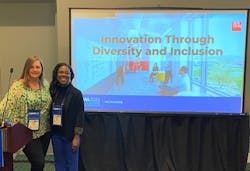3 Steps to Create More Diverse, Equitable and Inclusive Office Environments (BOMA 2022)
In their education session at the 2022 BOMA International Conference & Expo, “Innovation Through Diversity and Inclusion,” presenters Micki Washington, regional workplace director, and Adriana Rojas, director of interiors, both of HOK (pictured above), noted that architects, designers and facility executives need to explore how to create spaces that are more physically and culturally inclusive for people to allow them to thrive.
“Diversity is about counting the people, but inclusion is about making the people count,” Rojas said.
As a firm, she pointed out that HOK is endeavoring to see things from a variety of different characteristics, including: racial, gender, sexual orientation, age, socio-economic, physical abilities, mental health and religion.
“We can’t take one of these things as separate,” Rojas explained. “We have to see them as a whole.”
Taking Steps Toward Diversity and Inclusion
How does one go about creating and fostering spaces that are more equitable and diverse? Washington says it begins with Step 1: Embracing the 7 Principles of Universal Design, which include:
- Equitable Use—the design is useful and marketable to people with diverse abilities.
- Flexibility in Use—the design accommodates a wide range of individual preferences and abilities.
- Simple and Intuitive Use—use of the design is easy to understand, regardless of the user’s experience, knowledge, language skills, or current concentration or language levels.
- Perceptible Information—the design communicates necessary information effectively to the user, regardless of ambient conditions or user’s sensory abilities.
- Tolerance for Error—the design minimizes hazards and the adverse consequences of accidental or unintended consequences.
- Low Physical Effort—the design can be used efficiently and comfortably and with a minimum of fatigue.
- Size and Space for Approach and Use—appropriate size and space is provided for approach, reach, manipulation and use regardless of user’s body size, posture or mobility.
Step 2 involves Looking Internally at Yourself as an organization to determine if your culture, policies and practices align with the values of design and inclusivity. For HOK, this included forming equity committees to ensure that the firm’s design approach was equitable at every stage in the process for every client, as well as educating its staff internally about its diversity efforts. It also meant expanding community engagement, promoting health and wellness, and equitable access that breaks down social barriers.
“It’s not just what we want to design, but bringing the community in and making it more of a success,” Rojas said.
Step 3 requires that firms Embrace Evidence-based Design strategies and science that explain the relationship between neuroscience and physical space, a field that has been grossly overlooked historically, Washington said. While 1 in 7 people are considered neurodiverse, fewer than 50% are aware of the fact, she noted.
“We’re expecting people to thrive in spaces that don’t support them,” Washington said. “If we aren’t designing with the science of design, we can be negatively impacting the people that inhabit them.”
She added that physical, cognitive and social exclusion can occur at the point of interaction between the individual and an environment when there is a misalignment between them. “We need to design an ecosystem of different space types so people can naturally migrate to areas that meet their specific needs,” Washington said.
This means providing spaces within a floor plate (large or small) that allow for different work modes, including concentration/focus; communal; creative; meeting; contemplation; and social.
“We are no longer designing environments,” Rojas concluded. “We are designing the experience, and we want that experience to be positive for everyone in the workplace.”

